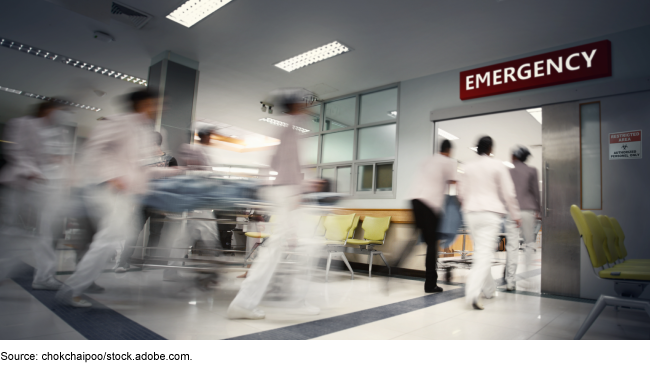Public Health Preparedness: COVID-19 Medical Surge Experiences and Related HHS Efforts
Fast Facts
Medical surges—i.e., influxes of patients that exceed a hospital's normal operating capacity—put enormous strain on a hospital's ability to care for patients.
Hospital representatives told us that, during some COVID-19 surges, they didn't have enough staff, supplies, or space to care for patients. Health care coalitions—regional groups of health care and response organizations—provided help, such as extra supplies.
HHS funds coalitions as part of its efforts to help hospitals and others manage surges. It is also developing guidelines to help organizations deal with future surges, among other ongoing efforts.

Highlights
What GAO Found
The COVID-19 pandemic has highlighted the importance of hospitals' abilities to evaluate and care for an increased volume of patients exceeding normal operating capacity, known as medical surge. All eight hospitals in GAO's review reported multiple challenges related to staff, supplies, space, or information. These are critical components for an effective medical surge response, according to the Department of Health and Human Services (HHS). All eight hospitals reported staffing challenges, such as a lack of staff to care for the increase in sick patients or staff becoming ill and unable to work, affecting hospital services. Hospitals took steps to address these challenges, such as supplementing staffing levels where possible or training staff on proper personal protective equipment use to prevent infection. Health care coalitions—groups of health care and response organizations in a defined geographic location supported by HHS funding—aided hospitals. For example, they helped coordinate patient transfers to balance hospital loads, obtain and distribute needed medical supplies, and communicate hospital needs to their states.
Health Care Workers Responding to the COVID-19 Pandemic

HHS has programs and activities underway intended to support medical surge readiness for hospitals and other health care organizations, but it is too soon to know the effectiveness of these efforts. For example, HHS implemented a new medical surge exercise for coalitions in 2021 to test readiness, and plans to establish targets to measure performance. It is also considering how to use the findings and lessons learned from its 2021 assessment of coalitions during the pandemic to improve its support of coalitions and their communities. HHS is also funding the development of a regional disaster health response system, which aims to develop effective approaches to medical surge response across multiple states. This includes improving data sharing on resource and capacity issues, and developing specialized teams that can respond to a range of hazards. HHS is considering its next steps regarding the expansion of this regional system. Further, HHS is developing regional guidelines for hospitals and other facilities related to treating patients and increasing medical surge capacity during public health emergencies as required by statute. Officials did not provide a date for when the guidelines would be made publicly available.
Why GAO Did This Study
HHS leads the nation's medical and public health preparedness for, response to, and recovery from emergencies and disasters. This includes helping hospitals and others build medical surge readiness. Emergencies, such as the COVID-19 pandemic, put enormous strain on hospitals in times of crisis.
The Pandemic and All-Hazards Preparedness and Advancing Innovation Act of 2019 includes a provision for GAO to review implementation of HHS's regional preparedness and response guidelines for hospitals and other facilities to increase medical surge capacity. Issuance of these guidelines has been delayed due to the continuing COVID-19 response, according to HHS. The CARES Act also includes a provision for GAO to report on the federal response to the pandemic. This report describes (1) medical surge challenges selected hospitals faced in responding to the COVID-19 pandemic and how health care coalitions have supported their efforts, and (2) selected HHS programs and activities underway to support medical surge readiness.
To do this work, GAO reviewed HHS and hospital documentation. GAO also interviewed HHS officials and representatives from a non-generalizable sample of eight hospitals and eight associated coalitions across three states. These states were selected based on their involvement in HHS regional preparedness and response efforts.
We provided a draft of this report to HHS for review and comment. HHS provided technical comments, which we incorporated as appropriate.
For more information, contact Mary Denigan-Macauley at (202) 512-8552 or DeniganMacauleyM@gao.gov.
